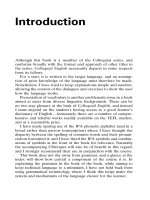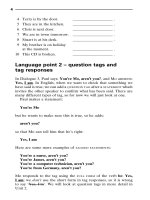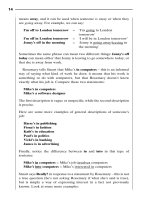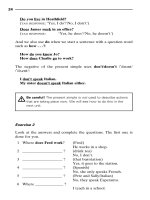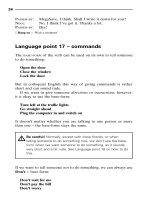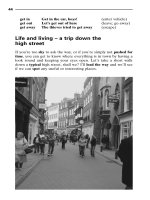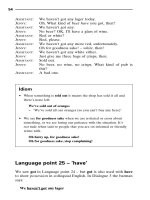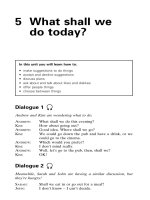A complete English language course part 7
Bạn đang xem bản rút gọn của tài liệu. Xem và tải ngay bản đầy đủ của tài liệu tại đây (345.26 KB, 10 trang )
get in Get in the car, boys! (enter vehicle)
get out Let’s get out of here (leave; go away)
get away The thieves tried to get away (escape)
Life and living – a trip down the
high street
If you’re too shy to ask the way, or if you’re simply not pushed for
time, you can get to know where everything is in town by having a
look round and keeping your eyes open. Let’s take a short walk
down a typical high street, shall we? I’ll lead the way and we’ll see
if we can spot any useful or interesting places.
44
Over here on the left, on our side of the street, is the super-
market, and right next to it there’s the post office – every town has
one of these somewhere, and you can tell it by its red sign. Over
there on the other side of the street you can see some smaller shops:
there’s a newsagent’s on the corner, and a couple of cafés – we
might go in one of those later for a cup of tea . . . what do you think?
Further down on the right is the bus station, and just behind that
you can probably just see the sports and leisure centre, which is
open to everyone; you can often find private sports and health clubs
in towns as well – they’re smaller and you have to pay to be a
member.
Now – can you see that big old building coming up on the left,
opposite the bus station? That’s the public library. Actually, that
reminds me – I’ve got to take some books back there today or
tomorrow, otherwise I’ll get a fine. Anyway, just a bit further on,
there are two banks, one on either side of the street, and then you
can see some traffic lights. Then there are some more small shops
just past the lights, including a butcher’s and a greengrocer’s, and
some Indian and Chinese restaurants. Then if we stop here outside
the pub and look straight ahead, that building in the distance is the
railway station – it’s about a ten-minute walk from the town centre.
There we are – a typical British high street. So now let’s go back
the way we came – I think I could do with that cup of tea now.
Glossary
shy – afraid to talk to people
pushed for time – with not much time; so ‘I’m not pushed for time’ means
‘I’ve got plenty of time’ or ‘I needn’t worry about time’
typical – usual, normal
lead the way – go first
spot – notice
over here – here near us
supermarket – large shop that sells all kinds of food
right next to – immediately next to, next door to
post office – public building where you can send letters and parcels
tell – recognise
sign – name board outside a shop
newsagent’s – shop that sells newspapers
corner – point where two roads join
couple of – two
1111
2
3
4
5
6
7
8
9
10
11
1211
13
14
15
16
17
18
19
20
21
22
23
24
25
26
27
28
29
30
31
32
33
34
35
36
37
38
39
40
41
4211
45
further – more far
just see – see with difficulty, see if you try hard
sports and leisure centre – public building where you can do sports and
fitness exercises
private – not open to the public
member – someone who belongs to a club or organisation
coming up – approaching
library – public building which lends books
reminds me – makes me remember
fine – a penalty, money you have to pay as punishment for something
a bit – a little
either side – both sides
traffic lights – red, yellow and green lights to control the traffic
butcher’s – shop that sells meat
greengrocer’s – shop that sells vegetables
restaurants – places where you can sit down and eat a meal
pub – place where you can sit and drink alcoholic drinks and eat food
railway station – place where trains stop
could do with – need
46
4 Have you got
any bread?
In this unit you will learn how to:
• use countable and uncountable nouns
• ask for and buy things in shops
• ask the price of something
• use numbers
• use British money
• say that you want or don’t want something
Dialogue 1
Helen is buying a few things in the corner shop.
H
ELEN
: Hello. Have you got any bread left?
A
SSISTANT
: Yes – we’ve got white and brown, sliced and
unsliced.
H
ELEN
: Give me a brown sliced loaf, please. Oh, and a box
of matches, and a bottle of milk.
A
SSISTANT
: Anything else?
H
ELEN
: Let’s see . . . some apples and some cat food.
A
SSISTANT
: How many apples would you like?
H
ELEN
: Half a dozen.
A
SSISTANT
: And how much cat food?
H
ELEN
: Two tins
1
will do, I think. How much does that
come to?
A
SSISTANT
: £5.86, please.
H
ELEN
:[gives the assistant the money]
Thanks a lot.
1111
2
3
4
5
6
7
8
9
10
11
1211
13
14
15
16
17
18
19
20
21
22
23
24
25
26
27
28
29
30
31
32
33
34
35
36
37
38
39
40
41
4211
A
SSISTANT
: Thank you. Bye.
H
ELEN
: Bye.
1 tin – a sealed metal container for food. The food in the tin can be either uncount-
able (cat food, ham, rice pudding) or countable (carrots, potatoes), but the tin
itself is always countable! Another word for tin is can, which is used in the UK
particularly for drinks. For an explanation of uncountable and countable nouns,
see Language point 23 below.
Language point 23 – counting and
quantity
There are two types of noun in English:
• nouns such as cup, egg, garden, book, mouse which are
COUNTABLE
(C)
• nouns such as water, milk, butter, food which are
UNCOUNTABLE
(UC)
They are used in different ways.
Countable nouns
• can have
PLURALS
: cups, eggs, gardens, books, mice
• are used in the singular with a/an: a cup, an egg, a garden
• can be used with numbers: three mice, seven books
• are used with many: how many cups?, too many books
Uncountable nouns
• usually can’t have plurals: ‘waters
’, ‘milks’, ‘butters’, ‘foods’
• usually can’t be used with a/an: ‘a water
’, ‘a milk’, ‘a food’
• are used with much: how much water?, too much food
• usually can’t be used with numbers: ‘three foods
’,
‘seven waters
’
48
Idioms
– will do means ‘will be enough’
– come to means ‘add up to’; how much does it come to? means
‘what is the total that I have to pay?’

